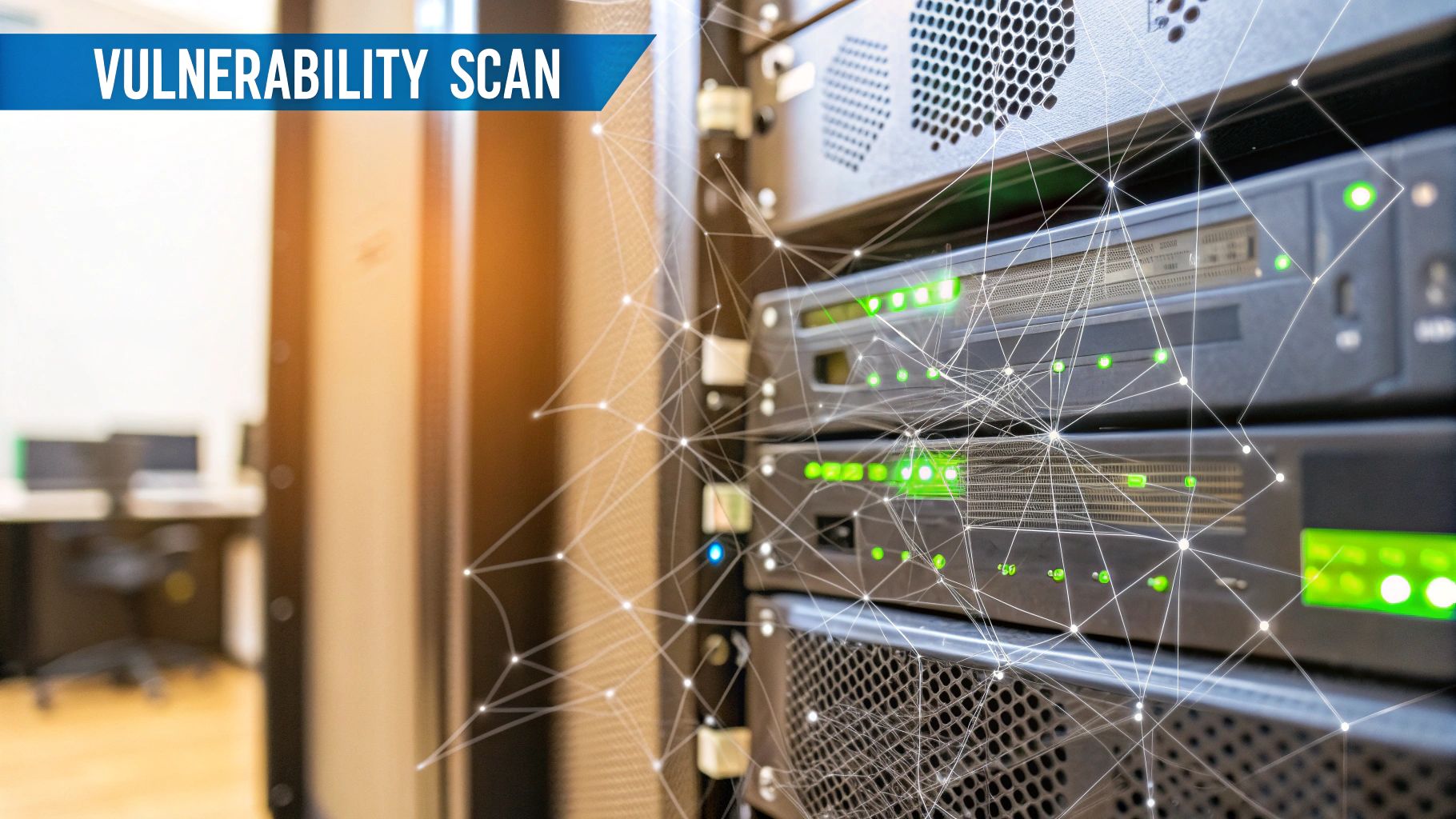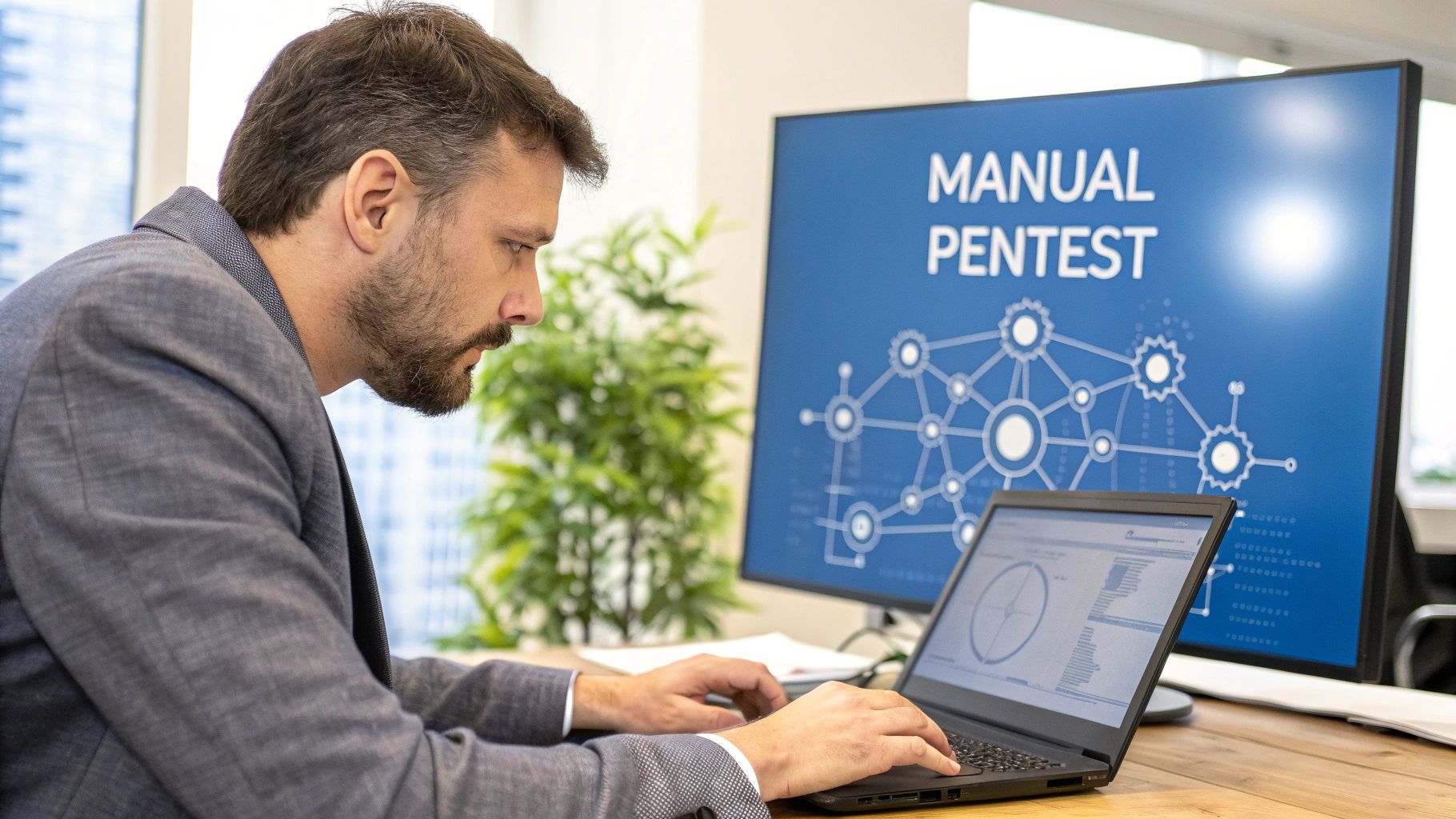The difference between these two services is huge. It all comes down to one simple idea: a vulnerability assessment makes a list of potential problems, while a penetration test is a hands-on attempt to exploit those problems.
Think of it like this. An assessment is like walking around a building and noting all the unlocked doors and windows. A pentest is hiring a professional to actually try and get inside to see what they can take.
Choosing The Right Security Test For Your Clients

As an MSP or vCISO, your clients trust you to be their security guide. Explaining the difference between a vulnerability assessment and a pentest is a great way to show your value. You become their strategic advisor, not just their IT provider.
The real difference is the how and the why. A vulnerability assessment is all about breadth and speed. It uses automated tools to quickly scan for known issues, which is great for regular security check-ups.
On the other hand, manual pentesting is a deep, focused dive. It mimics what a real attacker would do. This is the tough testing required to meet compliance standards like SOC 2, HIPAA, and PCI DSS. One is a quick overview, the other is proof of real risk. You can learn more about these testing differences from SentinelOne, but the main idea is that an assessment finds what could be a problem, while a pentest proves what is a problem.
What Vulnerability Assessments Uncover For MSPs

Vulnerability assessments are your go-to for routine security checks. Think of them as a wide-net automated scan that checks a client’s systems against a big library of known security flaws. The goal is breadth, not depth.
As a reseller, you can run these scans often—monthly or even weekly—to give clients a constant look at their security. For MSPs and GRC firms, this is the most efficient way to find common security holes before they become big problems. It’s an affordable service that shows your clients you are on top of their security.
But here’s the problem: the reports from these scans can be very noisy. They often list many potential issues, including false positives, without telling you which ones are a real, immediate risk. This is a key point in the penetration testing vs vulnerability assessment discussion. A vulnerability assessment answers the question, "What are our potential weaknesses?" It gives you a list to investigate but doesn't confirm if they can be exploited.
These scans are good for regular check-ups, but they won't meet compliance needs for frameworks like SOC 2 or PCI DSS. Our guide to security vulnerability scanning explains more. An assessment tells you the "what," but a pentest tells you the "so what."
How Manual Penetration Testing Validates Security

A manual penetration test is completely different from an automated scan. This is a goal-oriented test where our certified ethical hackers simulate a real cyberattack. It is the ultimate security validation for your client's business.
Instead of just getting a list of potential weaknesses, a pentester actively tries to exploit them. The objective isn't just to find flaws—it's to measure the actual business risk. This hands-on approach is what makes it a true security test.
Our team holds top certifications like OSCP, CEH, and CREST. They don't just follow a script. They think creatively like a real attacker and chain together multiple vulnerabilities to show the full impact. This is the service your clients need to meet compliance for PCI DSS, SOC 2, or ISO 27001. It proves their security can withstand a real human attacker—something a scan can never do. As your white label pentesting partner, we deliver this deep, manual validation affordably and quickly. Explore the various types of penetration testing to see how they benefit your clients.
Comparing The Final Pentest and Scan Reports
The final report is where the difference between a penetration test vs vulnerability assessment really shows. A vulnerability scan gives you a long, automated list of potential issues. You get a printout with dozens of findings and generic severity scores.
This leaves you, the MSP or vCISO, with a lot of work. You have to sort through the noise, figure out which findings are real, and prioritize what to fix. It’s a list of possibilities, not a clear action plan.
A manual penetration testing report tells a story. It’s a focused narrative from one of our ethical hackers detailing exactly how they broke in. It shows the specific steps they took, the real-world business impact, and answers the most important question: "What is the actual risk?" A vulnerability report gives you data. A penetration test report gives you intelligence. It's the difference between a phone book of threats and a dossier on the one that can actually break in. Our white label pentesting reports are built for you to deliver clear value. Check out this penetration testing report template to see what a strong deliverable looks like.
Guiding Clients On The Best Testing Method
Knowing when to recommend a vulnerability assessment versus a penetration test is a key skill for any MSP or vCISO. The choice is simple: one is for routine security checks, and the other is for proving defenses can withstand an attack.
A vulnerability assessment is your go-to for ongoing security maintenance. It’s perfect for quarterly health checks or for getting a baseline when you onboard a new client. It’s a proactive and highly affordable approach to security hygiene.
You should recommend a manual penetration test when the stakes are higher. This is essential when a client needs to meet a compliance mandate like PCI DSS, SOC 2, or HIPAA. It's also critical after a big infrastructure change or at least once a year to test their security strategy against a real-world attack simulation. Discover more insights about these security testing findings.
The Right Partner For Affordable Pentesting
The security industry often gives you a bad choice: fast, cheap scans or slow, expensive manual tests. We saw this problem in the industry and built our entire business to solve it for partners like you.
As your dedicated white label pentesting partner, we work for you. We never compete with you for your clients. We are here to make you look like the hero.
We deliver the expert, manual pentesting your clients need for compliance, but at a price that makes sense for your business. This means you can finally offer real security validation without the high prices and long waits that hurt your margins. It's the smart solution to the penetration testing vs vulnerability assessment problem. We are a 100% channel-only partner. Our mission is to empower MSPs, vCISOs, and GRC firms to grow their security offerings without worrying about a vendor stealing their clients. We are your silent, expert team.
Our certified testers, with credentials like OSCP and CEH, create high-quality reports you can brand as your own. You add a critical security service, drive more revenue, and become a strategic advisor. There's no need to build your own team or risk partnering with a competitor. We provide the affordable, expert, and channel-safe solution.
Your Top Questions About Pentesting Answered
How Often Should My Clients Get A Penetration Test?
Most clients will need a penetration test at least once a year, especially for compliance like SOC 2 and PCI DSS. It’s also smart to test after any big changes to their network or applications. Think of vulnerability scans as monthly check-ups and the pentest as the deep annual inspection that proves their defenses work.
Can A Vulnerability Scan Satisfy Compliance Requirements?
Almost never. For major standards like PCI DSS, HIPAA, and SOC 2, an automated scan isn't enough. These frameworks require proof that security holds up against a real attack. Only a manual pentest, where a human expert tries to break in, can provide the assurance your clients need for compliance.
How Does White Label Pentesting Benefit My MSP?
White label pentesting is a huge advantage. It lets you sell expert security services under your own brand without the high cost of an in-house team. You can expand your services, increase revenue, and strengthen your role as a true security partner. As a channel-only provider, we are your silent partner. We will never compete for your clients, so your customer relationships are always safe with you. Contact us today to learn more about our affordable partner program.

.avif)
.png)